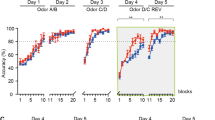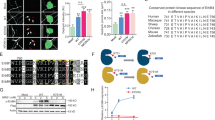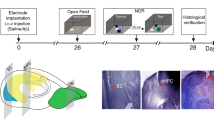Abstract
Olfactory dysfunction is increasingly recognized as an early indicator of Alzheimer’s disease (AD). Aberrations in GABAergic function and the excitatory/inhibitory (E/I) balance within the olfactory bulb (OB) have been implicated in olfactory impairment during the initial stages of AD. While the neuregulin 1 (NRG1)/ErbB4 signaling pathway is known to regulate GABAergic transmission in the brain and is associated with various neuropsychiatric disorders, its specific role in early AD-related olfactory impairment remains incompletely understood. This study demonstrated that olfactory dysfunction preceded cognitive decline in young adult APP/PS1 mice and was characterized by reduced levels of NRG1 and ErbB4 in the OB. Further investigation revealed that deletion of ErbB4 in parvalbumin interneurons reduced GABAergic transmission and increased hyperexcitability in mitral and tufted cells (M/Ts) in the OB, thereby accelerating olfactory dysfunction in young adult APP/PS1 mice. Additionally, ErbB4 deficiency was associated with increased accumulation of Aβ and BACE1-mediated cleavage of APP, along with enhanced CDK5 signaling in the OB. NRG1 infusion into the OB was found to enhance GABAergic transmission in M/Ts and alleviate olfactory dysfunction in young adult APP/PS1 mice. These findings underscore the critical role of NRG1/ErbB4 signaling in regulating GABAergic transmission and E/I balance within the OB, contributing to olfactory impairment in young adult APP/PS1 mice, and provide novel insights for early intervention strategies in AD.

This work has shown that ErbB4 deficiency increased the burden of Aβ, impaired GABAergic transmission, and disrupted the E/I balance of mitral and tufted cells (M/Ts) in the OB, ultimately resulting in olfactory dysfunction in young adult APP/PS1 mice. NRG1 could enhance GABAergic transmission, rescue E/I imbalance in M/Ts, and alleviate olfactory dysfunction in young adult APP/PS1 mice. OB: olfactory bulb, E/I: excitation/inhibition, Pr: probability of release, PV: parvalbumin interneurons, Aβ: β-amyloid, GABA: gamma-aminobutyric acid.
This is a preview of subscription content, access via your institution
Access options
Subscribe to this journal
Receive 12 print issues and online access
269,00 € per year
only 22,42 € per issue
Buy this article
- Purchase on SpringerLink
- Instant access to full article PDF
Prices may be subject to local taxes which are calculated during checkout








Similar content being viewed by others
Change history
26 July 2024
In the originally published article the ESM file has been omitted. This has been corrected.
References
The Alzheimer’s Association. 2022 Alzheimer’s disease facts and figures. Alzheimers Dement. 2022;18:700–89.
Piton M, Hirtz C, Desmetz C, Milhau J, Lajoix AD, Bennys K, et al. Alzheimer’s disease: advances in drug development. J Alzheimers Dis. 2018;65:3–13.
Dan X, Wechter N, Gray S, Mohanty JG, Croteau DL, Bohr VA. Olfactory dysfunction in aging and neurodegenerative diseases. Ageing Res Rev. 2021;70:101416.
Bathini P, Brai E, Auber LA. Olfactory dysfunction in the pathophysiological continuum of dementia. Ageing Res Rev. 2019;55:100956.
Murphy C. Olfactory and other sensory impairments in Alzheimer disease. Nat Rev Neurol. 2019;15:11–24.
Yan Y, Aierken A, Wang C, Song D, Ni J, Wang Z, et al. A potential biomarker of preclinical Alzheimer’s disease: the olfactory dysfunction and its pathogenesis-based neural circuitry impairments. Neurosci Biobehav Rev. 2022;132:857–69.
Mori K, Sakano H. Olfactory circuitry and behavioral decisions. Annu Rev Physiol. 2021;83:231–56.
Imamura F, Ito A, LaFever BJ. Subpopulations of projection neurons in the olfactory bulb. Front Neural Circuits. 2020;14:561822.
Jones S, Zylberberg J, Schoppa N. Cellular and synaptic mechanisms that differentiate mitral cells and superficial tufted cells into parallel output channels in the olfactory bulb. Front Cell Neurosci. 2020;14:614377.
Hu B, Geng C, Guo F, Liu Y, Zong YC, Hou XY. GABAA receptor agonist muscimol rescues inhibitory microcircuit defects in the olfactory bulb and improves olfactory function in APP/PS1 transgenic mice. Neurobiol Aging. 2021;108:47–57.
Wesson DW, Levy E, Nixon RA, Wilson DA. Olfactory dysfunction correlates with amyloid-beta burden in an Alzheimer’s disease mouse model. J Neurosci. 2010;30:505–14.
Wu N, Rao X, Gao Y, Wang J, Xu F. Amyloid-beta deposition and olfactory dysfunction in an Alzheimer’s disease model. J Alzheimers Dis. 2013;37:699–712.
Li W, Li S, Shen L, Wang J, Wu X, Li J, et al. Impairment of dendrodendritic inhibition in the olfactory bulb of APP/PS1 mice. Front Aging Neurosci. 2019;11:2.
Wang MD, Zhang S, Liu XY, Wang PP, Zhu YF, Zhu JR, et al. Salvianolic acid B ameliorates retinal deficits in an early-stage Alzheimer’s disease mouse model through downregulating BACE1 and Aβ generation. Acta Pharmacol Sin. 2023;44:2151–68.
McDade E, Voytyuk I, Aisen P, Bateman RJ, Carrillo MC, De Strooper B, et al. The case for low-level BACE1 inhibition for the prevention of Alzheimer disease. Nat Rev Neurol. 2021;17:703–14.
Yoo SJ, Lee JH, Kim SY, Son G, Kim JY, Cho B, et al. Differential spatial expression of peripheral olfactory neuron-derived BACE1 induces olfactory impairment by region-specific accumulation of beta-amyloid oligomer. Cell Death Dis. 2017;8:e2977.
Zhang XM, Xiong K, Cai Y, Cai H, Luo XG, Feng JC, et al. Functional deprivation promotes amyloid plaque pathogenesis in Tg2576 mouse olfactory bulb and piriform cortex. Eur J Neurosci. 2010;31:710–21.
De la Rosa Prieto C, Saiz Sanchez D, Ubeda Banon I, Flores Cuadrado A, Martinez Marcos A. Neurogenesis, neurodegeneration, interneuron vulnerability, and amyloid-β in the olfactory bulb of APP/PS1 mouse model of Alzheimer’s disease. Front Neurosci. 2016;10:227.
Wesson DW, Borkowski AH, Landreth GE, Nixon RA, Levy E, Wilson DA. Sensory network dysfunction, behavioral impairments, and their reversibility in an Alzheimer’s β-amyloidosis mouse model. J Neurosci. 2011;31:15962–71.
Hu B, Geng C, Hou XY. Oligomeric amyloid-beta peptide disrupts olfactory information output by impairment of local inhibitory circuits in rat olfactory bulb. Neurobiol Aging. 2017;51:113–21.
Batra S, Jahan S, Ashraf A, Alharby B, Jawaid T, Islam A, et al. A review on cyclin-dependent kinase 5: An emerging drug target for neurodegenerative diseases. Int J Biol Macromol. 2023;230:123259.
Pao PC, Tsai LH. Three decades of Cdk5. J Biomed Sci. 2021;28:79.
Lu TT, Wan C, Yang W, Cai Z. Role of Cdk5 in amyloid-beta pathology of Alzheimer’s disease. Curr Alzheimer Res. 2019;16:1206–15.
Maitra S, Vincent B. Cdk5-p25 as a key element linking amyloid and tau pathologies in Alzheimer’s disease: mechanisms and possible therapeutic interventions. Life Sci. 2022;308:120986.
Mei L, Xiong WC. Neuregulin 1 in neural development, synaptic plasticity and schizophrenia. Nat Rev Neurosci. 2008;9:437–52.
Chen YJ, Zhang M, Yin DM, Wen L, Ting A, Wang P, et al. ErbB4 in parvalbumin-positive interneurons is critical for neuregulin 1 regulation of long-term potentiation. Proc Natl Acad Sci USA. 2010;107:21818–23.
Zhang H, Zhang L, Zhou D, He X, Wang D, Pan H, et al. Ablating ErbB4 in PV neurons attenuates synaptic and cognitive deficits in an animal model of Alzheimer’s disease. Neurobiol Dis. 2017;106:171–80.
Robinson HL, Tan Z, Santiago Marrero I, Arzola EP, Dong TV, Xiong WC, et al. Neuregulin 1 and ErbB4 kinase actively regulate sharp wave ripples in the hippocampus. J Neurosci. 2022;42:390–404.
Wang H, Liu F, Chen W, Sun X, Cui W, Dong Z, et al. Genetic recovery of ErbB4 in adulthood partially restores brain functions in null mice. Proc Natl Acad Sci USA. 2018;115:13105–10.
Li B, Woo RS, Mei L, Malinow R. The neuregulin-1 receptor erbB4 controls glutamatergic synapse maturation and plasticity. Neuron. 2007;54:583–97.
Luo B, Liu Z, Lin D, Chen W, Ren D, Yu Z, et al. ErbB4 promotes inhibitory synapse formation by cell adhesion, independent of its kinase activity. Transl Psychiatry. 2021;11:361.
Wen L, Lu YS, Zhu XH, Li XM, Woo RS, Chen YJ, et al. Neuregulin 1 regulates pyramidal neuron activity via ErbB4 in parvalbumin-positive interneurons. Proc Natl Acad Sci USA. 2009;107:1211–6.
Gao YZ, Wu XM, Zhou ZQ, Liu PM, Yang JJ, Ji MH. Dysfunction of NRG1/ErbB4 signaling in the hippocampus might mediate long-term memory decline after systemic inflammation. Mol Neurobiol. 2023;60:3210–26.
Yoo JY, Kim HB, Baik TK, Lee JH, Woo RS. Neuregulin 1/ErbB4/Akt signaling attenuates cytotoxicity mediated by the APP-CT31 fragment of amyloid precursor protein. Exp Mol Pathol. 2021;120:104622.
Tian J, Geng F, Gao F, Chen YH, Liu JH, Wu JL, et al. Down-regulation of Neuregulin1/ErbB4 signaling in the hippocampus is critical for learning and memory. Mol Neurobiol. 2017;54:3976–87.
Tan Z, Liu Z, Liu Y, Liu F, Robinson H, Lin TW, et al. An ErbB4-positive neuronal network in the olfactory bulb for olfaction. J Neurosci. 2022;42:6518–35.
Lu Y, Sun XD, Hou FQ, Bi LL, Yin DM, Liu F, et al. Maintenance of GABAergic activity by neuregulin 1-ErbB4 in amygdala for fear memory. Neuron. 2014;84:835–46.
Li KX, Lu YM, Xu ZH, Zhang J, Zhu JM, Zhang JM, et al. Neuregulin 1 regulates excitability of fast-spiking neurons through Kv1.1 and acts in epilepsy. Nat Neurosci. 2011;15:267–73.
Liu XY, Wang K, Deng XH, Wei YH, Rui Guo R, Liu SF, et al. Amelioration of olfactory dysfunction in a mouse model of Parkinson’s disease via enhancing GABAergic signaling. Cell Biosci. 2023;13:101.
Dewan A, Pacifico R, Zhan R, Rinberg D, Bozza T. Non-redundant coding of aversive odours in the main olfactory pathway. Nature. 2013;497:486–9.
Zhu Y, Demidov ON, Goh AM, Virshup DM, Lane DP, Bulavin DV. Phosphatase WIP1 regulates adult neurogenesis and WNT signaling during aging. J Clin Invest. 2014;124:3263–73.
Liu J, Liu C, Zhang J, Zhang Y, Liu K, Song JX, et al. A Self-assembled alpha-synuclein nanoscavenger for Parkinson’s disease. ACS Nano. 2020;14:1533–49.
Yin DM, Sun XD, Bean JC, Lin TW, Sathyamurthy A, Xiong WC, et al. Regulation of spine formation by ErbB4 in PV-positive interneurons. J Neurosci. 2013;33:19295–303.
Wen L, Tang FL, Hong Y, Luo SW, Wang CL, He W, et al. VPS35 haploinsufficiency increases Alzheimer’s disease neuropathology. J Cell Biol. 2011;195:765–79.
Zhang HL, Zhao B, Yang P, Du YQ, Han W, Xu J, et al. Steroid receptor coactivator 3 regulates synaptic plasticity and hippocampus-dependent memory. Neurosci Bull. 2021;37:1645–57.
Bi LL, Sun XD, Zhang J, Lu YS, Chen YH, Wang J, et al. Amygdala NRG1–ErbB4 is critical for the modulation of anxiety-like behaviors. Neuropsychopharmacology. 2015;40:974–86.
Lepousez G, Mouret A, Loudes C, Epelbaum J, Viollet C. Somatostatin contributes to in vivo gamma oscillation modulation and odor discrimination in the olfactory bulb. J Neurosci. 2010;30:870–5.
Laukka EJ, Ekstrom I, Larsson M, Grande G, Fratiglioni L, Rizzuto D. Markers of olfactory dysfunction and progression to dementia: A 12-year population-based study. Alzheimers Dement. 2023;19:3019–27.
LaFever BJ, Imamura F. Effects of nasal inflammation on the olfactory bulb. J Neuroinflammation. 2022;19:294.
Ohm TG, Braak H. Olfactory bulb changes in Alzheimer’s disease. Acta Neuropathol. 1987;73:365–9.
Struble RG, Clark HB. Olfactory bulb lesions in Alzheimer’s disease. Neurobiol Aging. 1992;13:469–73.
Thomann PA, Dos Santos V, Toro P, Schönknecht P, Essig M, Schröder J. Reduced olfactory bulb and tract volume in early Alzheimer’s disease–a MRI study. Neurobiol Aging. 2009;30:838–41.
Chen M, Chen Y, Huo Q, Wang L, Tan S, Misrani A, et al. Enhancing GABAergic signaling ameliorates aberrant gamma oscillations of olfactory bulb in AD mouse models. Mol Neurodegener. 2021;16:14.
Min SS, An J, Lee JH, Seol GH, Im JH, Kim HS, et al. Neuregulin-1 prevents amyloid β-induced impairment of long-term potentiation in hippocampal slices via ErbB4. Neurosci Lett. 2011;505:6–9.
Ryu J, Hong BH, Kim YJ, Yang EJ, Choi M, Kim HS, et al. Neuregulin-1 attenuates cognitive function impairments in a transgenic mouse model of Alzheimer’s disease. Cell Death Dis. 2016;7:e2117.
Kim YJ, Yoo JY, Kim OS, Kim HB, Ryu J, Kim HS, et al. Neuregulin 1 regulates amyloid precursor protein cell surface expression and non-amyloidogenic processing. J Pharmacol Sci. 2018;137:146–53.
Maestu F, de Haan W, Busche MA, DeFelipe J. Neuronal excitation/inhibition imbalance: core element of a translational perspective on Alzheimer pathophysiology. Ageing Res Rev. 2021;69:101372.
Bi D, Wen L, Wu Z, Shen Y. GABAergic dysfunction in excitatory and inhibitory (E/I) imbalance drives the pathogenesis of Alzheimer’s disease. Alzheimers Dement. 2020;16:1312–29.
Breton Provencher V, Bakhshetyan K, Hardy D, Bammann RR, Cavarretta F, Snapyan M, et al. Principal cell activity induces spine relocation of adult-born interneurons in the olfactory bulb. Nat Commun. 2016;7:12659.
Lin TW, Tan ZB, Barik A, Yin DM, Brudvik E, Wang HS, et al. Regulation of synapse development by vgat deletion from ErbB4-positive interneurons. J Neurosci. 2018;38:2533–50.
Liu G, Froudarakis E, Patel JM, Kochukov MY, Pekarek B, Hunt PJ, et al. Target specific functions of EPL interneurons in olfactory circuits. Nat Commun. 2019;10:3369.
Saiz Sanchez D, Flores Cuadrado A, Ubeda Bañon I, de la Rosa Prieto C, Martinez Marcos A. Interneurons in the human olfactory system in Alzheimer’s disease. Exp Neurol. 2016;276:13–21.
Jimenez Balado J, Eich TS. GABAergic dysfunction, neural network hyperactivity and memory impairments in human aging and Alzheimer’s disease. Semin Cell Dev Biol. 2021;116:146–59.
Xu Y, Zhao M, Han Y, Zhang H. GABAergic inhibitory interneuron deficits in alzheimer’s disease: implications for treatment. Front Neurosci. 2020;14:660.
Funamoto S, Tagami S, Okochi M, Morishima Kawashima M. Successive cleavage of β-amyloid precursor protein by γ-secretase. Semin Cell Dev Biol. 2020;105:64–74.
Kiss E, Groeneweg F, Gorgas K, Schlicksupp A, Kins S, Kirsch J, et al. Amyloid-β fosters p35/CDK5 signaling contributing to changes of inhibitory synapses in early stages of cerebral amyloidosis. J Alzheimers Dis. 2020;74:1167–87.
Sadleir KR, Vassar R. Cdk5 protein inhibition and Aβ42 increase BACE1 protein level in primary neurons by a post-transcriptional mechanism. J Biol Chem. 2012;287:7224–35.
Mei L, Nave KA. Neuregulin-ERBB signaling in the nervous system and neuropsychiatric diseases. Neuron. 2014;83:27–49.
Rudenko A, Seo J, Hu J, Su SC, de Anda FC, Durak O, et al. Loss of cyclin-dependent kinase 5 from parvalbumin interneurons leads to hyperinhibition, decreased anxiety, and memory impairment. J Neurosci. 2015;35:2372–83.
Rakic S, Kanatani S, Hunt D, Faux C, Cariboni A, Chiara F, et al. Cdk5 phosphorylation of ErbB4 is required for tangential migration of cortical interneurons. Cereb Cortex. 2015;25:991–1003.
Kim SH, Ryan TA. CDK5 serves as a major control point in neurotransmitter release. Neuron. 2010;67:797–809.
Kim SH, Ryan TA. Balance of calcineurin Aα and CDK5 activities sets release probability at nerve terminals. J Neurosci. 2013;33:8937–50.
Acknowledgements
Thanks to Prof. Lin Mei (Chinese Institutes for Medical Research) and Prof. Xiao-ming Li (Zhejiang University) for the generous gift of loxp-flanked ErbB4 mice and PV-Cre mice. Thanks to Prof. Jie Zhang (Xiamen University) for kindly providing antibodies of CDK5 and p35.
Funding
The work was supported by the National Natural Science Foundation of China (82274301 and 81774377), the Natural Science Foundation of Fujian Province of China (2021J01019), the National Key Research and Development Program of China (2016YFC1305903) and the Program for New Century Excellent Talents in University of China (NCET-13-0505).
Author information
Authors and Affiliations
Contributions
LW designed the experiments, supervised the project. XHD and XYL wrote the manuscript, LW, GQZ and SFL edited the manuscript. XHD, YHW and KW performed the Western blotting experiments and analyzed the data. XHD, XYL, YHW and RG performed the electrophysiological experiments. JJZ and JYZ analyzed the electrophysiological data. JRZ, MDW, and QHY performed the immunostaining., YHW, YFZ, JYZ and JJZ helped with animal breeding, behavioral experiments as well as data analysis. YJC, JQH, ZXC, SQH and CSL have directly accessed and verified the underlying data reported in the manuscript. All authors read and approved the final manuscript.
Corresponding authors
Ethics declarations
Competing interests
The authors declare no competing interests.
Rights and permissions
Springer Nature or its licensor (e.g. a society or other partner) holds exclusive rights to this article under a publishing agreement with the author(s) or other rightsholder(s); author self-archiving of the accepted manuscript version of this article is solely governed by the terms of such publishing agreement and applicable law.
About this article
Cite this article
Deng, Xh., Liu, Xy., Wei, Yh. et al. ErbB4 deficiency exacerbates olfactory dysfunction in an early-stage Alzheimer’s disease mouse model. Acta Pharmacol Sin 45, 2497–2512 (2024). https://doi.org/10.1038/s41401-024-01332-6
Received:
Accepted:
Published:
Issue Date:
DOI: https://doi.org/10.1038/s41401-024-01332-6



